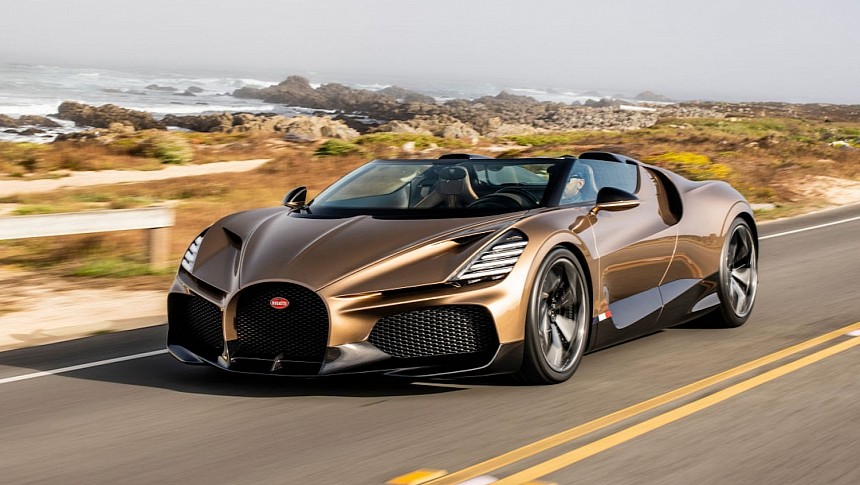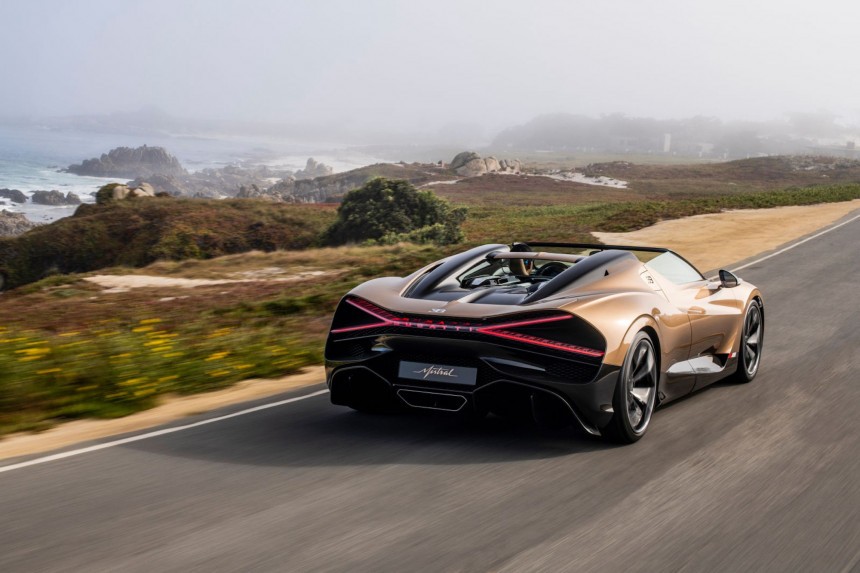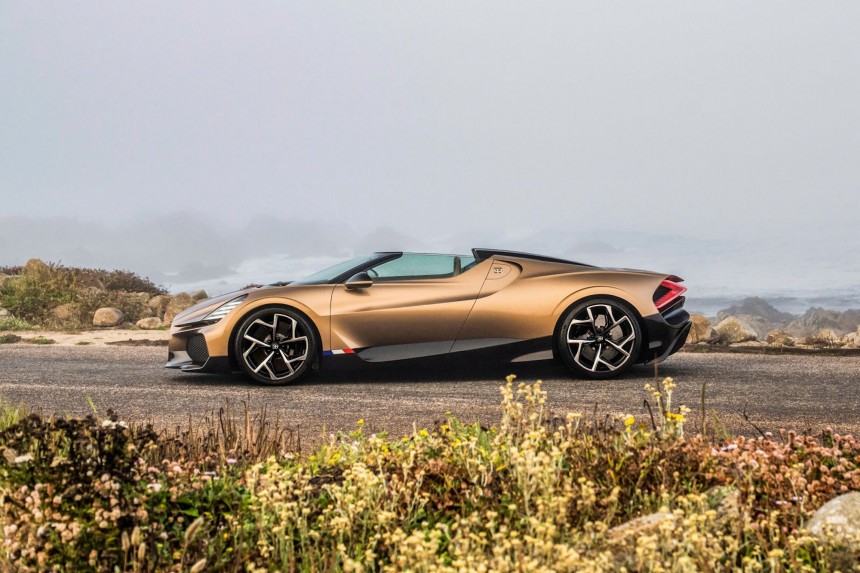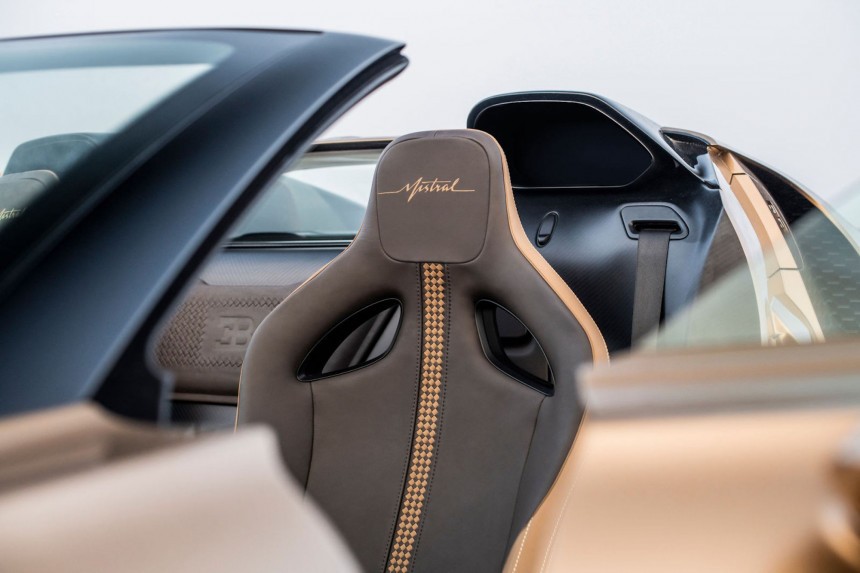The Bugatti Mistral is the brand's last W16-powered car before the supreme engine goes into retirement for good. The Mistral is also Bugatti's first roadster since the Veyron Grand Sport Vitesse from 2012. The Mistral is the car that should have never existed.
"The Chiron family never intended to have a roadster," said Emilio Scervo, Chief Technology Officer of Bugatti Rimac. And then, the W16 Mistral happened.
There was a time when open tops were the norm for the Bugatti brand. The eldest son of Ettore Bugatti, Jean, was the one who wanted them, designed them, engineered them, and test-drove them. It was the mid-1920s through to the late 1930s, and the Bugatti roadsters were these built-to-perfection automobiles.
The Type 40 A, the Type 41 Roadster Esderrs, the Type 55 Roadster, and the Type 57 Roadster Grand Raid Gangloff, with the latter being the muse for the Mistral, came with their grandiose names and stances to awe the car enthusiasts of the era. The exclusive and exotic Mistral arrived as a tribute to all those iconic models.
When they debuted this out-of-this-world mid-engine two-seater, the French chose a black and yellow variant. It was the color combination preferred by Ettore Bugatti himself for his personal cars.
Fast forward over seven decades, and the Bugatti Mistral arrived with its supreme W16 to stand proud as the brand's first roadster since the Veyron Grand Sport Vitesse, which premiered back in 2012.
The Mistral is the swan song of the W16 engine, a masterpiece of engineering first used in the Chiron Super Sport 300+. The 8.0-liter quad-turbocharged unit is capable of roaring out 1,578 horsepower (1,600 metric horsepower) and 1,180 pound-feet (1,600 Newton meters) of torque delivered to all four corners via a seven-speed dual-clutch automatic transmission.
Those are the parameters that make it flash from zero to hero (0 to 60 mph or 0 to 97 kph) in 2.4 seconds on its way to a top speed of – are you sitting down? – 261 mph (420 kph). That is more than the speed of a passenger jet on the runway before takeoff.
Bugatti says that there is no roadster like the Mistral when it comes to craftsmanship and luxury, and we tend to believe them. When it comes to price, too. The French hypercar manufacturer had to find a way to make it compliant with the ever more stringent crash regulations. And had to do that at over 260 mph.
And that wasn't exactly the easiest of missions. It was a car that had no roof that the company was dealing with. Somehow, they nailed it, and the Bugatti Mistral entered production at the factory in Moselheim. The model is not a convertible derivative of the Chiron, but a separately developed roadster, which is not based on the Chiron or any other Bugatti model with the pillars cut off to make way for the open-top design. However, it does not stray from the DNA of the brand's roadsters.
Ultra-high-performance lightweight composite materials and complex structures reduce the mass gained after the engineers increased the rigidity of the chassis. Furthermore, the doors are designed to absorb an exceptional amount of energy in the event of a side impact in order to keep those on board safe.
Bugatti had to completely redesign the air intake system and had to come up with innovative ram induction air scoops placed behind the headrests to protect the occupants in the event of a rollover. The scoops are made from a bespoke carbon fiber structure that is capable of supporting the weight of the entire car if it flips over.
It sports uniquely designed headlights with four diagonal light strips, while at the opposite end, the designers came up with taillights in the shape of arrows pointing to the Bugatti badge.
The cabin, though, follows the lines and implements the cutting-edge technology of the Chiron, with the gear lever splitting it from its step-sibling. The layout is a tribute to the work of sculptor Rembrandt Bugatti, Ettore's brother, integrating the “dancing elephant” sculpture embedded in amber, similar to what the Type 41 Royale came with, in the late 1920s.
The gear shifter is machined from a solid block of aluminum. Woven leather covers the newly designed door panels.
And it is not just the glorious W16 that provides the soundtrack on board, but also the high-end sound system that was specifically developed for the roadster. The engineers had to make it sound impeccable even with the top down at high speeds when the mistral wind blows like no tomorrow.
Bugatti is only making 99 W16-powered Mistrals. Each starts at $5 million. A price which is a clear statement that this car goes straight into the stratosphere of supercars. The model was sold out days after it was unveiled.
There was a time when open tops were the norm for the Bugatti brand. The eldest son of Ettore Bugatti, Jean, was the one who wanted them, designed them, engineered them, and test-drove them. It was the mid-1920s through to the late 1930s, and the Bugatti roadsters were these built-to-perfection automobiles.
The Type 40 A, the Type 41 Roadster Esderrs, the Type 55 Roadster, and the Type 57 Roadster Grand Raid Gangloff, with the latter being the muse for the Mistral, came with their grandiose names and stances to awe the car enthusiasts of the era. The exclusive and exotic Mistral arrived as a tribute to all those iconic models.
When they debuted this out-of-this-world mid-engine two-seater, the French chose a black and yellow variant. It was the color combination preferred by Ettore Bugatti himself for his personal cars.
The Mistral is the swan song of the W16 engine, a masterpiece of engineering first used in the Chiron Super Sport 300+. The 8.0-liter quad-turbocharged unit is capable of roaring out 1,578 horsepower (1,600 metric horsepower) and 1,180 pound-feet (1,600 Newton meters) of torque delivered to all four corners via a seven-speed dual-clutch automatic transmission.
Those are the parameters that make it flash from zero to hero (0 to 60 mph or 0 to 97 kph) in 2.4 seconds on its way to a top speed of – are you sitting down? – 261 mph (420 kph). That is more than the speed of a passenger jet on the runway before takeoff.
Bugatti says that there is no roadster like the Mistral when it comes to craftsmanship and luxury, and we tend to believe them. When it comes to price, too. The French hypercar manufacturer had to find a way to make it compliant with the ever more stringent crash regulations. And had to do that at over 260 mph.
Ultra-high-performance lightweight composite materials and complex structures reduce the mass gained after the engineers increased the rigidity of the chassis. Furthermore, the doors are designed to absorb an exceptional amount of energy in the event of a side impact in order to keep those on board safe.
Bugatti had to completely redesign the air intake system and had to come up with innovative ram induction air scoops placed behind the headrests to protect the occupants in the event of a rollover. The scoops are made from a bespoke carbon fiber structure that is capable of supporting the weight of the entire car if it flips over.
It sports uniquely designed headlights with four diagonal light strips, while at the opposite end, the designers came up with taillights in the shape of arrows pointing to the Bugatti badge.
The gear shifter is machined from a solid block of aluminum. Woven leather covers the newly designed door panels.
And it is not just the glorious W16 that provides the soundtrack on board, but also the high-end sound system that was specifically developed for the roadster. The engineers had to make it sound impeccable even with the top down at high speeds when the mistral wind blows like no tomorrow.
Bugatti is only making 99 W16-powered Mistrals. Each starts at $5 million. A price which is a clear statement that this car goes straight into the stratosphere of supercars. The model was sold out days after it was unveiled.










